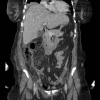A snake in the grass: retroperitoneal abscess due to perforated appendicitis-management, approach and recommendations
- PMID: 31186833
- PMCID: PMC6537909
- DOI: 10.1093/jscr/rjz163
A snake in the grass: retroperitoneal abscess due to perforated appendicitis-management, approach and recommendations
Abstract
A perforated retrocecal appendix resulting in a retroperitoneal abscess is a rare complication of a common disease. The first description of this condition was published in 1948. We present a case involving a 50-year-old woman who presented with abdominal pain inconsistent with the typical presentation of acute appendicitis and was eventually found to have a perforated retrocecal appendix accompanied by a retroperitoneal abscess. The patient was diagnosed using CT and operated upon but unfortunately had a resistant inflammatory process that led to persistent pus drainage from the abdomen despite multiple evacuation attempts and a prolonged hospital stay. In such cases, if the source of this type of inflammatory process has not yet been controlled or even identified, we recommend a second surgical examination, with additional surgical examinations as needed, and offer other suggestions.
Figures
References
-
- Hardin DM., Jr Acute appendicitis: review and update. Am Fam Physician 1999;60:2027–34. - PubMed
-
- Hsieh CH, Wang YC, Yang HR, Chung PK, Jeng LB, Chen RJ. Retroperitoneal abscess resulting from perforated acute appendicitis: analysis of its management and outcome. Surg Today 2007;37:762–7. - PubMed
-
- van den Wildenberg FA. The retrocaecal appendix: a snake in the grass. Neth J Surg 1982;34:133–5. - PubMed
-
- Bird GC Jr., Fissel GE, Young BR. A pathognomonic roentgen sign of retroperitoneal abscess; report of two cases of ruptured appendix with positive roentgen findings. Am J Roentgenol Radium Ther 1948;59:351–3. - PubMed
Publication types
LinkOut - more resources
Full Text Sources


